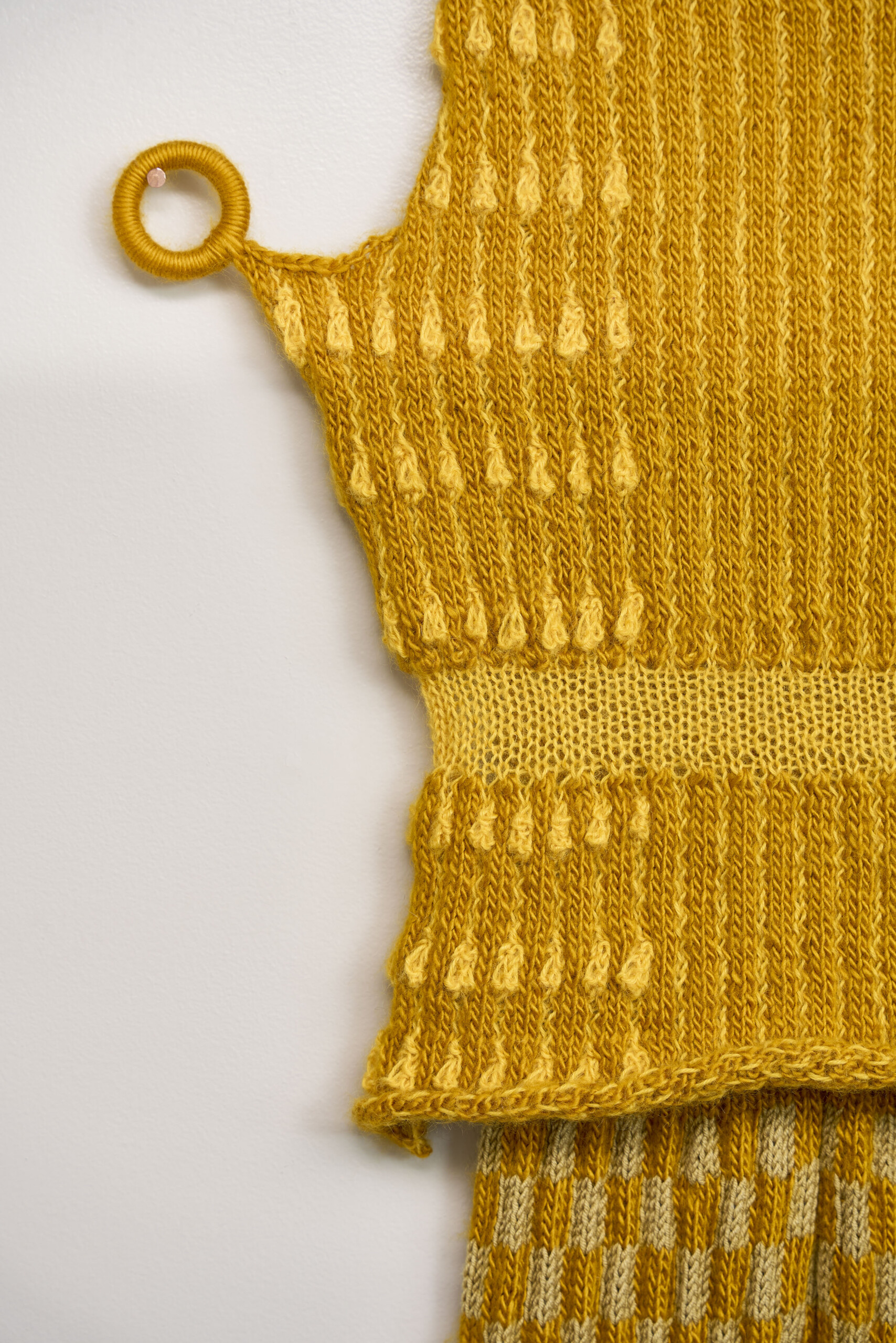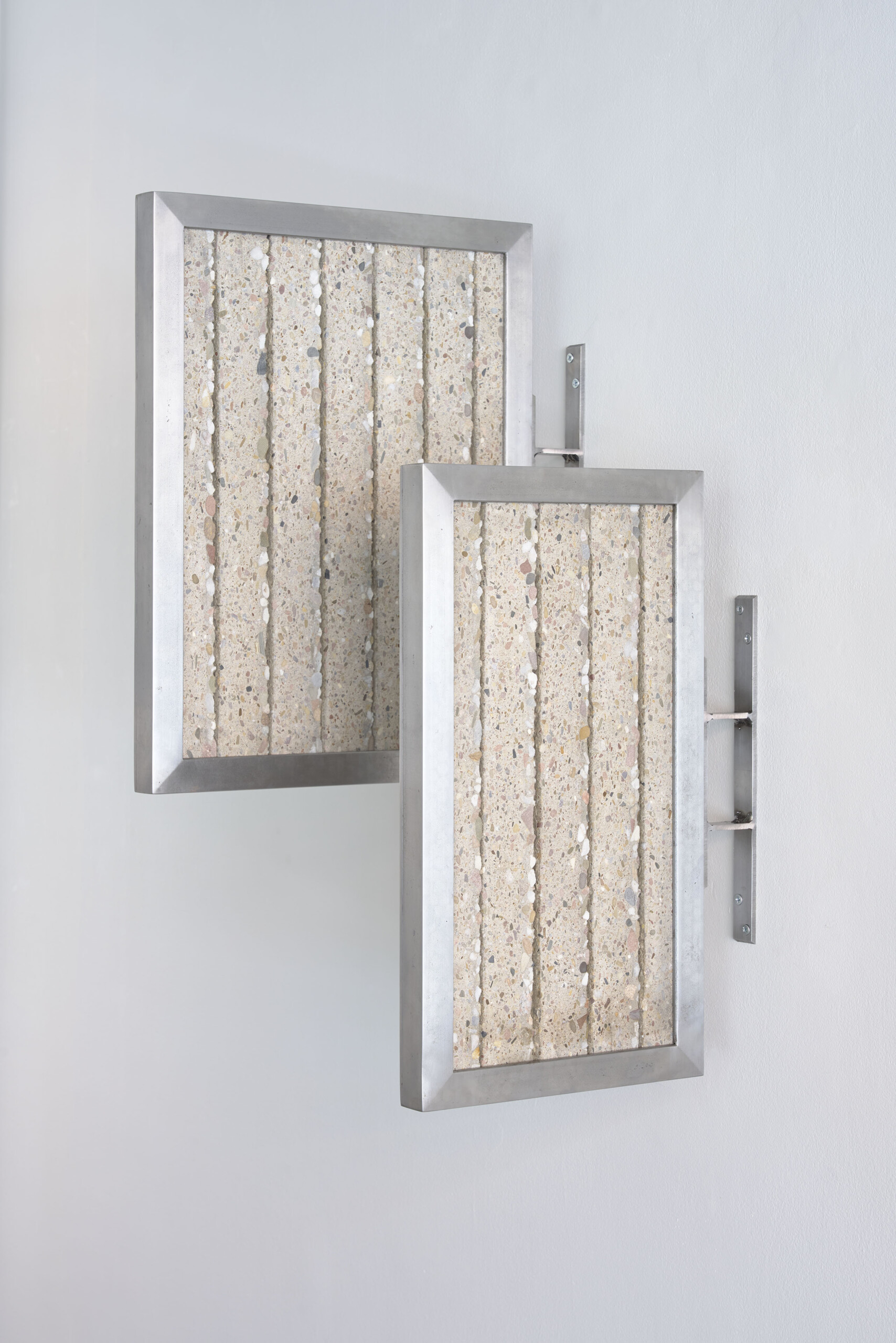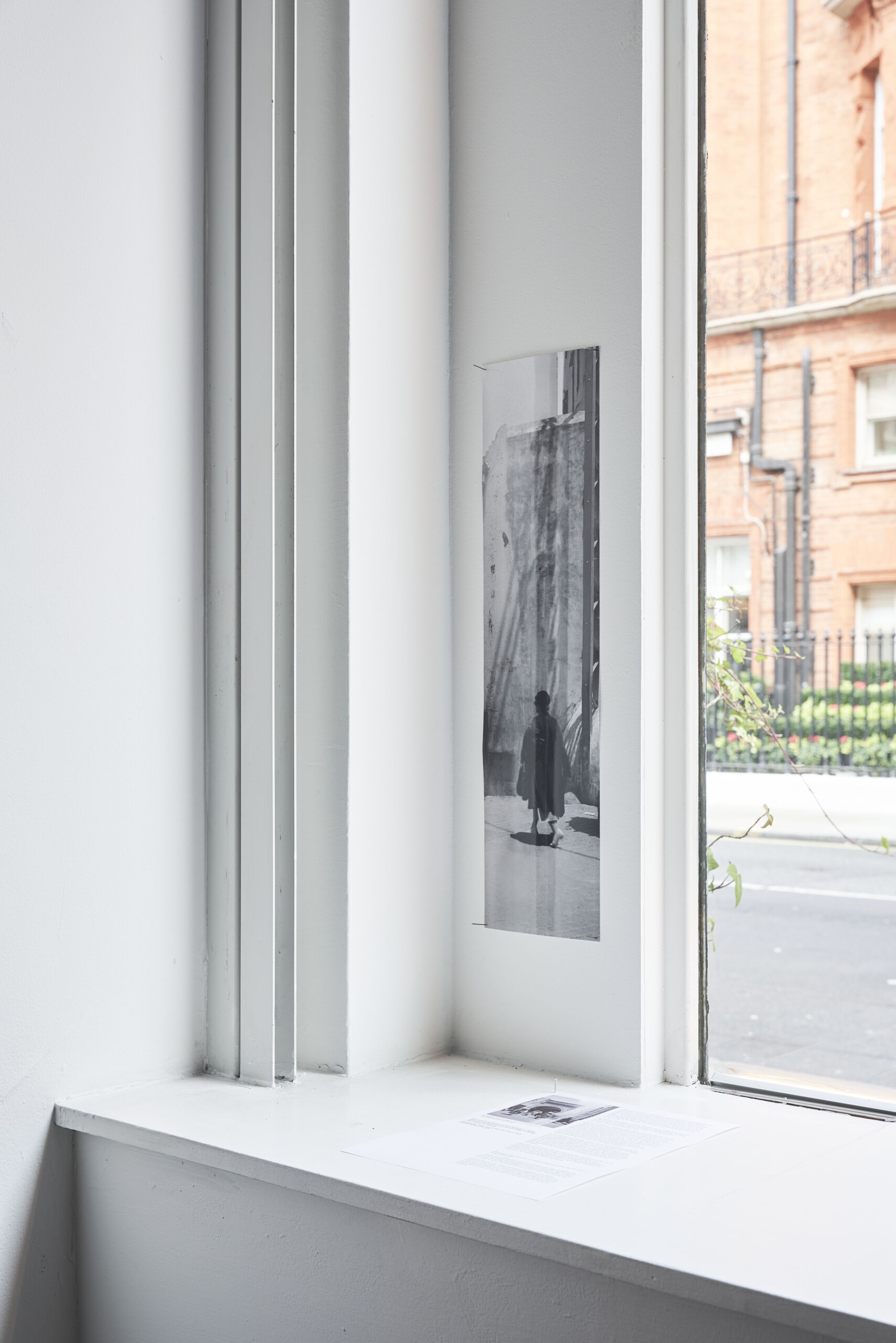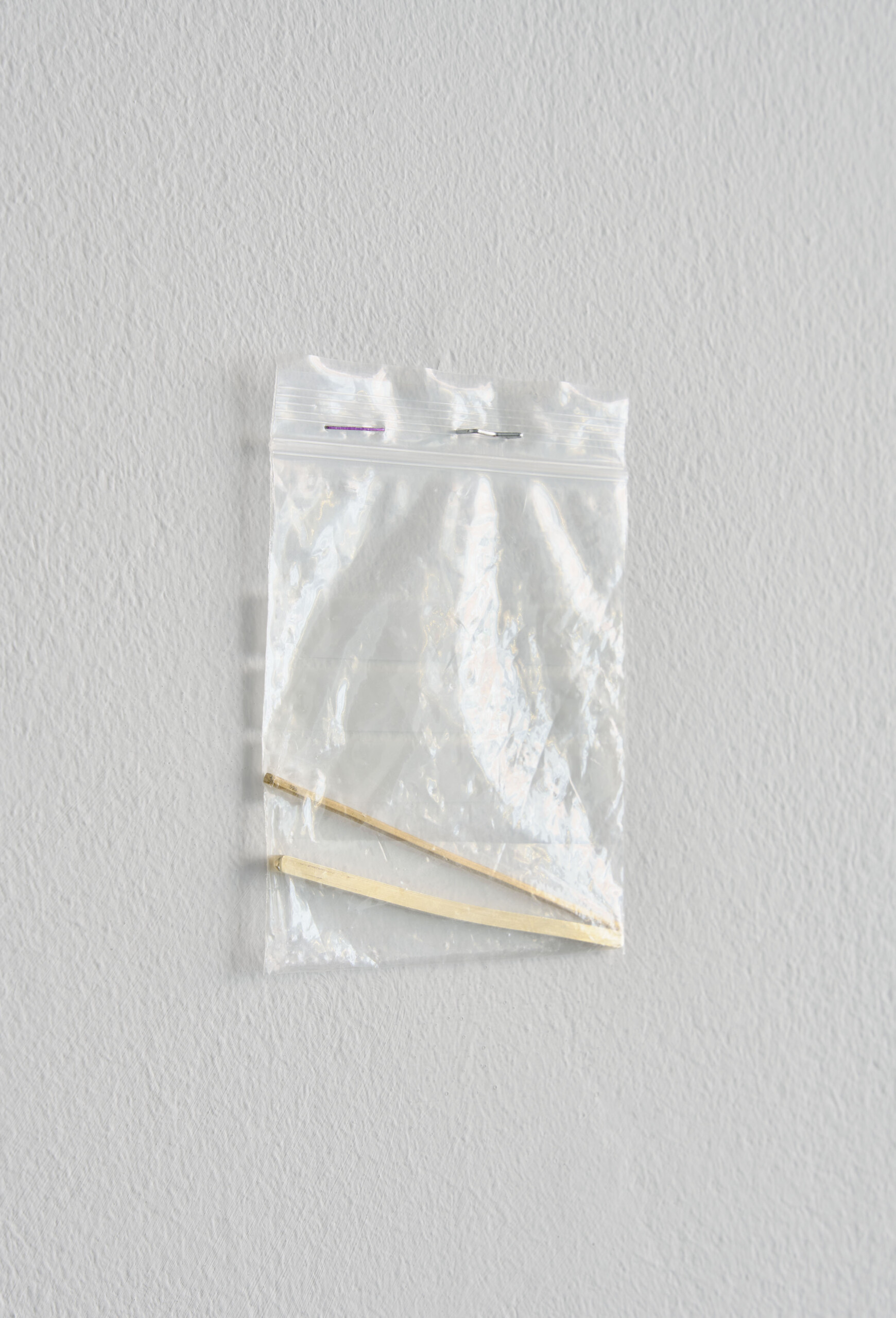6 October 2023 — 22 December 2023
Women of the ’20s
Coco Crampton • Agata Madejska • Hanna Mattes • Devin T. Mays • Sadie Murdoch • Lydia Ourahmane and Daniel Blumberg • Ronit Porat • Anna Wachsmuth • Ines Weizman

Installation View
Belmacz’s Autumn 2023 exhibition, Women of the ’20s celebrates artistic practices that ‘jazz’ the known. Echoing the radical freedom often associated with the ‘twenties,’ a sense of innovation, desire and sparky new found life, the artists ensembled [sic] here each utilise processes of subversion in order to shake up ways of seeing. That is, through covert operations, observations, re-re-stagings, exchanges, and vivacious plays each of the artists in Women of the ’20s embrace sleight of hand to metaphorically sidestep what has come before, demanding that we feel the beat in life’s shift changes.
We are not in the business of looking back with fondness nor nostalgia. And neither are the artists in this exhibition. Their artworks do not operate through fantasy or romance. Rather, embracing syncopation and porousness, each artist’s work speaks beyond arbitrary material categories and positions. Here, the grains of media and mediums shift and shake, not knowing where to stop, they writhe with a gold-tipped energy becoming their own after-glow, their own recumbent sound and legacy.

Ines Weizman, A woman in Tangier, 1935, 2023
print on c-type gloss paper, 59.4 x 15 cm
Coco Crampton
Operating through a distinct set of aesthetic references, from Victorian furniture to iconic 20th-century design, Coco’s practice co-opts domestic processes to create artworks with a potential to perform beyond their given face.

Coco Crampton, Timekeeper, 2023
hand knitted wool, cooper nails, 60 x 143 cm
Timekeeper, 2023 is a knitted two-piece; pinstriped and checkered. Meticulously crafted over a number of years, the work not only stands as a testament to Coco’s artistic labours but alludes to her position as a new mother. Further, overtly pinned to the gallery’s wall, the kitted caprice becomes something of a soft jab and gesture, pointing to the performative means adopted by bodies in order to function ‘properly’ within a disembodied consumptive society.

Coco Crampton, Timekeeper, 2023
hand knitted wool, cooper nails, 60 x 143 cm
Agata Madejska
Agata’s artworks question the forms and functions of political rhetoric. Working through photographic and post-photographic processes, she is specifically interested in the ways political language shapes how bodies manoeuvre through the world.

Agata Madejska, Housing A (Work Life Balance), 2023
organza, toy car wrecks, marbles, lighter, ring pulls, tweezers, nail clipper, found earrings, star brooch, polo sugar tree, steel whistle, key, 20p, 5p, variable
Building upon her investigations into the ways cultural, economic and political narratives become architectural, Agata’s works linger ominously in the gallery’s space. Sheening grey and hand-stitched from raw organza, the formalities of construction here give of these pieces a ghost-like presence. In this way, they echo, or at least suggest, how ideologies of value and ownership find their corporeal form, haunting our being and social ways in life.

Agata Madejska, Shelters, 2023
hand-sewn organza, wire , 28 x 22 x 11 cm (approx.)
In anticipation of her 2023 artist book, Mistakes Were Made (Edition Taube), Shelters, 2023 is a handmade limited edition which gives a loose sculptural form to Agata’s long-term engagement with structures of power and how these become known in the body.
Priced at £300 (+ vat and shipping), all proceeds raised from this edition directly support the production of Mistakes Were Made.
Hanna Mattes
At once appearing static, the anomalous worlds Hanna constructs question notions of ‘real’ and ‘fallacy’, holding just ajar the clean surface narrative of things so as to evoke a sense of animate depth.

Hanna Mattes, (left) Aquatic Antipode 7; (right) Aquatic Antipode, 11, 2022
c-print, negative collage, 25 x 30 cm or 80 x 100 cm
Part of her series Aquatic Antipode (which forms the larger body of work Take Me to That Landscape, a publication project that also encompasses a musical album and texts by various authors) these photographic works picture the horizon; the meeting of swathes of water and sky, bubbling. Looking at these scenes closely, it becomes apparent that these are not records of a singular place. Rather they are composites, seas and skies from elsewheres brought together to manufacture a sense of tranquillity. And in this way, they poetically speak about a human desire for togetherness. Indeed, about the gaps and the unseen distances overcome through collaboration.
Devin T. Mays
Devin’s work serves the idea that art is a way of being attuned to the world, a sensitivity to the unspectacular and idiosyncratic ways that viewers encounter and create relationships and meaning with dormant, commingling stuff.
Devin T. Mays, [trailer] Record, Light, 2023
video
04:36 min
Devin’s ambient video, Record, Light, 2023 depicts a large orb of glowing light tentatively touched by a smaller beam. Like a moth circling a flame or a solar flare, this small vessel tiptoes around its burgeoning companion. Alluding to the artist’s wider practice of wandering—of circling back and forth in the world, coming across naturally occurring sculptural ‘moments’ in the built environment, and allowing these to become conditions for his works—here, this simple recording becomes a melodic gesture, a revelatory intervening, something speaking to the everything and nothing found as moves through the world.
Devin T. Mays, Record, Light, 2023
video, 04:36 min
Sadie Murdoch
Employing methods of re-staging and photo-montage, Sadie explores the nature of the photographic document as a construct. Indeed, often working with images of the body, her artworks force us to consider how we are constructed and whose hands are at play in this forming.

Sadie Murdoch, Constellation, 2023
photo print on Hahnemühle paper with artist's steel frame, 99 x 91 cm
The visual remains of archival history are given new life through Sadie’s photo prints. Specifically, in Constellation, 2023 Sadie works with a thumbnail photograph depicting the Bauhaus’ weaving department, questioning how histories become hidden by examining this image through 21st-century processes of image enhancement. Developed using a Hasselblad Imacon Flextight scanner—a unique machine that extracts incredible detail from film and other materials—Sadie scanned this thumbnail image through a fabric vail of glitter mesh. This artistic process at once occludes the original image whilst also conceptually alluding to the ways in which history becomes hidden. In this way, Sadie gives the lives held in the off-white pages of the archive a new sense of aliveness, one that glitters close by but that retains the starlit quality of temporal mystery.

Sadie Murdoch, Abbot's El at Columbus, Broadway and Avenue, 2023
photo print on Hahnemühle paper with artist's steel frame, 58 x 42.6 cm
Lydia Ourahmane and Daniel Blumberg
As a conceptual collaboration, materially divergent artworks by Lydia Ourahmane and Daniel Blumberg appear together in this exhibition.

Lydia Ourahmane and Daniel Blumberg, installation view
At an interpretive level, both artists work through process. Specifically, for Women of the ’20s both artists entered into a process whereby they were each given a 10.7-gram length of 18ct yellow gold and used this to produce of their respective artwork.
Lydia Ourahmane and Daniel Blumberg, merma, 2023
10.38g 18kt gold, 4.04g 24kt gold, staple, plastic baggy The piece is accompanied by a bespoke frame/casing and its documentation, 8 x 10 cm
Lydia Ourahmane and Daniel Blumberg, merma, 2023
10.38g 18kt gold, 4.04g 24kt gold, staple, plastic baggy The piece is accompanied by a bespoke frame/casing and its documentation, 8 x 10 cm
Lydia’s work can often be seen as the almost forensic logging of exchanges, how arcane trades and translations operate across differing socio-cultural contexts, so as to call out the space of the human body in autonomous systems of power.
In the piece developed for Women of the ’20s, Lydia leant into this practice of recording, exploring how her gold could materially transform while retaining its innate ‘value’ –a socially politically loaded term, often associated with fiscal validation. Here, after exploring various options for exchange, Lydia had her 18ct length of gold refined, so as to produce a 24ct length. Thinned, or emaciated, Lydia’s pure gold rests in a grip seal bag–a “baggy” to use the artist’s term–next to the broader stick of gold gifted to Daniel, a testament not only to their differing approach but an allusion to the value of multiplicity.

Daniel Blumberg, merma drawings 1-16, 2023
18kt yellow gold and gesso on paper, perspex, 59.4 x 84.1 cm
A slight alteration, or play on his wider practice of Silverpoint drawing, for his part in this collaboration Daniel developed a series of small Goldpoint drawings. Rather than depicting a caricature of life, his figurative drawings teeter the line between what is seen and what is felt. That is, dangly in form and rendered all stuttery through their medium body, these drawings transform the latency of life into something glimmering and joyous.
Ronit Porat
Ronit’s artistic practice begins with extensive research in photo archives, collecting images from various sources, merging different taxonomies and periodical readymades with personal autobiographical references.

Ronit Porat, Untitled, 2017
photographic collage on Hahnemhüle bamboo paper, 35 x 50 cm
The cut-up photomontages included in Women of the ’20s directly relate to Ronit’s publication Hunting in Time, a publication that revisits a murder that took place in Berlin in January 1931. As a continuation of her practice, these images allude to the voices sequestered or effaced by the churning of time. In the exhibition space, they linger with a surreal presence, one that is strangely inviting, harrow and quiet; evidence of all that is not seen.

Ronit Porat, Untitled, 2019
photographic collage on Hahnemhüle bamboo paper, 40 x 43 cm
Anna Wachsmuth
Anna’s practice has shifted between photography, printmaking, sound, sculpture and cross-disciplinary collaborations. Often alluding to forms of social and political accountability, Anna’s recent works embrace the subtleties of material.

Anna Wachsmuth, Untitled (Burnt Oak), 2022
steel, sliced concrete slab, wax, oil
In this exhibition, part of Anna’s 2021 installation Eiche Brennt [Oak Burns], two aluminium frames holding lengths of raw pebbled concrete, are affixed to the gallery’s walls. In their jutting presence, this heavy pair hover counterintuitively haunting the space with something of its material fabrication, its history.
Ines Weizman
Ines, an architectural historian and theorist, works with ‘documentary methods’. Her research focuses on the history of international modernism and Bauhaus architecture. Recently, she has been dealing with the history of modern architecture and design in relation to issues of migration and colonial modernism.

Ines Weizman, A woman in Tangier, 1935, 2023
print on c-type gloss paper, 59.4 x 15 cm
The photograph and floating image caption included in Women of the ’20s is an edited still from Ines’ 2023 video essay, first installed as part of her exhibition at the Biennale Architettura 2023, Venice, Italy. In this video, Ines traces Joséphine Baker’s militant connections in North Africa and the Middle East. Co-opting the freedom afforded to her as a performing body, Baker’s underground activities for the anti-fascist Allied forces in the region operated through entertainment. Held in relation to contemporary events, the work conveys the radicality offered through a performative sleight of hand.

Ines Weizman, A woman in Tangier, 1935, 2023
print on c-type gloss paper, 59.4 x 15 cm
Artist biographies
Coco Crampton (b.1983, London, UK), studied at Norwich School of Art and Design before graduating from the Royal Academy Schools in 2014. Co-opting craft traditions through playful gesture, Coco’s work breathes new life into historical forms, ranging from Victorian furniture to 20th-century design icons. Weaving together function and fiction Coco’s work embodies a performativity, activated in the imagination of the viewer.
Agata Madejska (b.1979, Warsaw, Poland), graduated from Folkwang University of the Arts, Essen in 2007 and the Royal College of Art, London in 2010. Through post-(and)photographic processes, sculptural interventions, and installation, Agata delves into the multiple ways in which power can be manifest. With their liquidus feel, her works question the smooth façades of language, architecture, and public agreements – forms that hold associative or symbolic value. In turn, Agata poses deeply philosophical questions which demand viewers to think and re-think how we have come to know not only our world but ourselves in this world-space – how and why.
Hanna Mattes (b.1980, Munich, Germany), studied Fine Arts at Gerrit Rietveld Academy in Amsterdam and Linguistics at Freie Universität zu Berlin. With an interest in that which lies beyond optical capture – be this screen or lens, the filmic or the celestial – Hanna takes photographic processes as a point of departure. Through different modes of direction and documentation, her work expands fantasies, creating multiverses, where a viewer is led to question notions of ‘real’ and ‘fallacy.’ Surpassing ‘the photographic,’ Hanna’s recent work employs sound and her body to make explicit the tensions between these notions and there effect on psychosocial behaviour.
Devin T. Mays (b. 1985, Detroit, USA) originally studied Business Administration at Howard University (Washington, DC) before completing his Master of Fine Arts at University of Chicago in 2016. Devin’s practice is an attempt to trust in materials. Often working with found objects, in his works the materials being used do not present themselves as anything other than what they are. And in this way, Devin highlights how the physicality of a thing transforms through one’s mental engagement with it. For Devin this process of transformation is more akin to intuition and revelation, than to invention and revolution.
Sadie Murdoch (b.1965, Hexham, Northumberland) studied at Chelsea College of Art and Design and Leeds Metropolitan University. She was a student on the Whitney Museum of American Art Independent Study Programme, New York from 2003-2004, and an Abbey Rome Scholar at the British School at Rome in 2002. In Sadie’s photographs, she often appears as an incarnation of a historical character or event. She is part of the work in a material sense, in the re-enacted gestures and poses, the making and marking of the objects and surfaces. The registers of the drawn, the photographed and the real merge and force a consideration of how we construct and are constructed by, our encounter with the archival.
Lydia Ourahmane (b. 1992, Saϊda, Algeria) she studied at Camberwell College of Arts (London) before completing her studies at Goldsmiths University, London in 2014. Spanning video, sound, performance, installation, sculpture, Lydia’s multidisciplinary work is imbued with spirituality, contemporary geopolitics, colonial histories, and migration. Drawing on personal and collective experiences and narratives, she questions institutional structures such as surveillance, logistics and bureaucratic processes, and the way they exercise authority.
Daniel Blumberg (b. 1990, London, UK) is a musician and visual artist. In 2016 he was awarded a scholarship to study at the Royal Drawing School. Embracing the ancient technique of Silverpoint, his drawings are often of a figurative nature. Describing his practice, the curator Hans Urlich Obrist wrote Daniel’s drawings “moves very delicately between the two worlds – between music and art.” Without a discernible narrative Daniel’s works appear as joyous, conveying the rhythmical movements of a life.
Ronit Porat (b. 1975, Kibbutz Kfar Giladi, northern Israel) studied at Hadassah College in Jerusalem, before completing her MFA at Chelsea College of the Arts, London, in 2006. Embracing photography, her work blends archival materials and biographical texts to create installations as well as two-dimensional works. Her artist book Hunting in Time (Sternthal Books) will be published in late 2023. In this, Ronit draws from a trilogy of exhibitions about a mysterious crime committed in Berlin at the turn of the century to tell an overlooked history through the medium of collage.
Anna Wachsmuth (b.1989, Minden, Germany) after studying Photography and Media at Fachhochschule Bielefeld, and Bezalel Academy of Arts and Design Jerusalem, in 2015 she moved to Glasgow to study Painting and Printmaking at Glasgow School of Arts before completing her MFA at Goldsmiths University in 2022. Often working through installation, Anna’s work revolves around a cross-disciplinary reflection on a materials and forms, think about formalities can reveal differing cultural histories.
Ines Weizman (b. Leipzig, Germany) is an architect and theorist whose method ‘Documentary Architecture’ studies the material history of buildings, media and technology artefacts. Ines was trained as an architect at the Bauhaus University Weimar and the Ecole d’Architecture de Belleville in Paris, Cambridge University, and the Architectural Association where she completed her PhD thesis in History and Theory in 2005. She is currently the head of the PhD Programme at the School of Architecture, Royal College of Art, London.
Enquiries
Please contact us directly gallery@belmacz.com with any enquiries. Please note that all works are subject to prior sales and tax where applicable.









